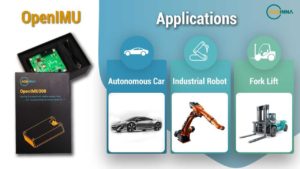The Hailo-8 processor features up to 26 tera-operations per second and is smaller than a penny.
‘Robomorphic computing’ aims to quicken robots’ response time
Contemporary robots can move quickly. “The motors are fast, and they’re powerful,” says Sabrina Neuman. Yet in complex situations, like interactions with people, robots often don’t move quickly. “The hang up is what’s going on in the robot’s head,” she adds. Perceiving stimuli and calculating a response takes a “boatload of computation,” which limits reaction…
Researchers develop powerful optical neuromorphic processor
Researchers said the optical neuromorphic processor could benefit autonomous vehicles and other data-intensive applications.
NVIDIA DRIVE AGX Orin to power next generation of Einride autonomous Pods
Einride said NVIDIA’s Orin processors will help make the next generation of its autonomous Pods for freight transport safer and more functional.
CronAI senseEDGE platform joins Ouster lidar to bring 3D perception to robots, vehicles
Ouster and CronAI are combining their award-winning lidar sensor and platform for processing image data at the edge, respectively, for 3D perception for early customers.
Aeva makes SPAC deal to scale up production of 4D lidar on a chip for self-driving cars
Aeva has entered into an agreement with special purpose acquisition company InterPrivate Acquisition Corp. to scale up production of its 4D lidar sensor on a chip, which it said can benefit autonomous vehicles and robotics.
NVIDIA Jetson can enable hybrid edge/cloud processing for robots, says Formant CEO
When using Jetson devices, Formant users can now enable real-time video and image analytics in the cloud and perform PII scrubbing at the edge, writes CEO Jeff Linnell in this column.
Jetson Nano 2GB designed by NVIDIA to make AI, robotics development more accessible
NVIDIA said its Jetson Nano 2GB kit is designed to enable students and developers to affordably get started with AI, robotics, and IoT.
Hailo-8 powers new M.2 and Mini PCIe AI acceleration modules for edge devices
Hailo said its new M.2 and Mini PCIe modules, which use the Hailo-8 AI processor, will make it easier for developers to build high performance into edge devices than other current systems.
ACEINNA OpenIMU ROS driver designed to aid robotics developers with navigation
ACEINNA has released its OpenIMU ROS driver, which it said will make it easier for robotics developers to build precise navigation systems.
Wheelchair mounted robot arm to use Intel neuromorphic technology to assist patients
Intel, Accenture, the Open University, ALYN Hospital, and Applied Brain Research are working to apply neuromorphic technology to make wheelchair-mounted robot arms more adaptable and affordable.
ADLINK field CTO describes value of edge AI, ROS 2, and faster robotics development
Joe Speed, field CTO of ADLINK, explains how ROS 2 is intended for commercial robotics developers, how the COVID-19 pandemic has accelerated demand, and how perception and fleet management can improve.
NUS researchers improve robot sensing abilities with Intel Loihi neuromorphic chip
A novel system made of up neural networks powered by Intel’s Loihi neuromorphic chip could lead to better robotic senses of touch and vision, according to NUS researchers.
Hologram Hyper card and software designed to widen IoT device connectivity
Hologram Hyper uses eUICC SIM hardware and software to help connect IoT devices such as robots, drones, and autonomous vehicles across cellular coverage zones.
Phantom AI, Renesas develop low cost ‘full stack’ driver assistance system
Phantom AI, which develops advanced driver-assistance systems, is putting its technology on Renesas’ system on chip to provide computer vision, sensor fusion, and control capabilities.
Qualcomm Robotics RB5 Platform puts 5G, AI in developers’ hands
The Qualcomm Robotics RB5 Platform helps developers tap into 5G and AI to create high-compute, power-efficient robots for a variety of industries.
Accelerator technique from Intel could benefit edge robotics and augmented reality
Intel shared four research papers on new edge processing techniques, including one on a raycast accelerator that could improve visual SLAM accuracy while maintaining energy efficiency.
Optical phased array on chip promises to revolutionize autonomous navigation
Columbia researchers have developeed a new optical phased array on chip at both near-infrared and blue wavelengths. It could advance autonomous navigation, augmented and virtual reality, and neuroscience.
Solid-state lidar from Sense Photonics designed for safer robots, vehicles
Solid-state lidar such as the cameras from Sense Photonics could help increase warehouse safety by perceiving forklift forks more accurately.
Robots on a chip could move droplets for biomedical applications
‘Ferrobots,’ or magnetically controlled robots on a chip, promise to revolutionize medical diagnostic testing and other industries, just as Amazon’s warehouse robots have, said UCLA researchers.
Why and how to run machine learning algorithms on edge devices
Machine learning on edge devices could transform the manufacturing, healthcare, and energy industries. An AI executive explains why and the hardware involved.
Arbe raises $32M to bring high-res radar for autonomous vehicles to market
Arbe, an Israel-based startup developing 4D radar technology that it claimed generates images 100 times more accurate than anything currently available on the market, raised funds for productization.






















